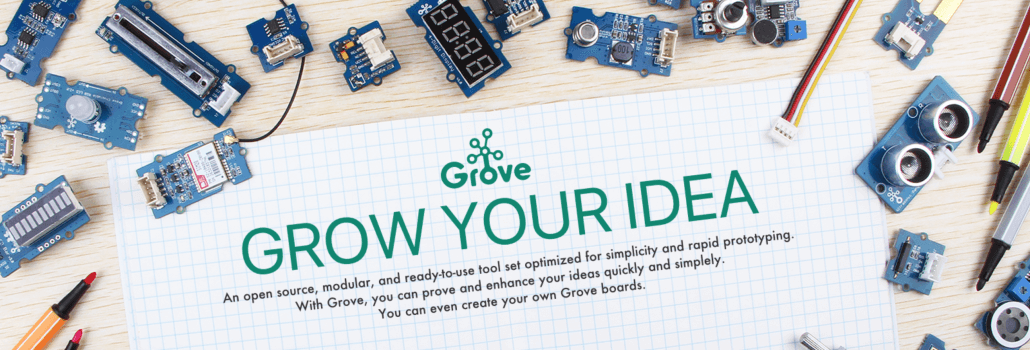Grove Ultimate Selection Guide
We prepared a detailed Grove products ultimate selection guide to help you quickly compare and choose the most suitable modules and sensors for your projects.

In this guide, we listed 202 Grove products and divided them into the following categories and listed the corresponding specification of each product:
- Robotic
- Motion
- Proximity
- Biomedical
- Relays
- Wireless
- Environment
- Displays and LEDs
- Inputs/ Human Machine Interface
- Actuators
- Communication
We also listed previous blogs to help you more quickly get started and compare different types of sensors. We will keep updating more guides, please keep in touch and let us know what other guides are you looking forward to seeing!
Robotic
Want to know how to build an Arduino robot? This guide will also show you the kits, and projects to help you easily get started in building one!
In the past, building robots was an expensive and tough task to handle due to the vast number of parts and experience needed. However, with the availability of Arduino and the kits, arms, and parts that go alongside it, robotics is now a fun and exciting process that’s very much affordable!
Proximity
Please also check our previous introduced different types of proximity and distance sensors.
Inductive, Capacitive, Ultrasonic, IR? These are the common types of proximity sensors used today for varying applications, ranging from Andriod and iPhone proximity sensing, to distance measurement, object detection, with Arduino. Hence, picking one that’s easily connectable, accurate, and reliable is very much important for fulfilling your intended usages.
This guide will cover the following components:
- What are proximity sensors?
- Types of proximity sensors
- How to pick a proximity sensor
- Honorable mentions
- Proximity sensor compared (Summary)
When it comes to distance sensors, there are many types; ultrasonic, IR proximity, laser distance, etc. and selecting the right one for your next Arduino or Raspberry Pi project could be a tough task to handle. Hence, today we’ll be looking at the plethora of distance sensors, its types, and answering which one is best suited for you!
This blog will introduce a SHARP proximity sensor and discuss how to easily connect it with your Arduino for a plethora of applications!
Biomedical
This blog talks about a specific type of sensors: Biomedical Sensors. They are sensors that detect medically relevant parameters which ranges from simple physical parameters like heart rate, galvanic skin response to muscle movements. Through this article, you will learn about:
- Examples and Types of Biomedical Sensors
- How does it work
- Seeed’s Biomedical sensors
The Grove – Fingerprint Sensor Module, typically used in safes, it’s highly powered by a DSP AS601 chip that does the image rendering, calculation, feature-finding and searching. Sufficient onboard FLASH memory allows for up to 162 fingerprints to be stored as well!
Not only can you use this fingerprint sensor module for your Arduino or Raspberry Pi projects, but it’s also simple to get started, and easily integrated into other microcontrollers through TTL serial.
When it comes to EMG sensor with Arduino, Myoware is the one you’ve probably only heard of. However, here at Seeed, we offer a cheaper alternative for your EMG applications!
Displays and LEDs
With so many types of LEDs out in the market, how do you pick one that suit your Arduino project the most? No worries, as we have come up with a guide to help you pick the right LED for your project!
Today, through this blog, we are going to cover:
- Best LEDs for Arduino
- LED Drivers with Arduino
- Arduino LED Project ideas
Inputs/ Human Machine Interface
HMI also known as Human Machine Interface, is a display that allows the user to control and monitor their machines. One common example of an HMI would be an ATM machine where a user will use the screen and buttons to withdraw or deposit money.
Actuators
When using the Arduino, there are many projects and things that you can do with it and one of them includes driving a motor! Today, through this tutorial, we will be focusing on the 3 basic motors that you can drive with the Arduino which are the DC motor, Servo motor, and Stepper motor.
The Arduino has always been used to control motors. A few examples would be the DC motor, servo motor, and stepper motor. Today, we are going to cover 2 motors, DC and Servo Motor, which are widely being used by many electronic hobbyists and makers due to their simplicity and functions.
To get you started, in today’s blog, we will cover 2 ways you can control a DC motor using your Arduino and how to control a Servo Motor with the Arduino.
We will keep updating this form and we look forward to suggestions from you! Please feel free to let us know your thoughts in our forum, we will carefully listen to and take action!

